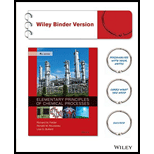
Concept explainers
(a)
Interpretation:
The final temperature of the air stream is to be determined.
Concept introduction:
A flowchart is the complete representation of a process through boxes or other shapes which represents process units and arrows that represents the input and output of the process. The flowchart must be fully labelled to infer important data about the process involved.
In a system, a conserved quantity (total mass, mass of a particular species, energy or momentum) is balanced and can be written as:
Here, ‘ input’ is the stream which enters the system. ‘ generation’ is the term used for the quantity that is produced within the system. ‘ output’ is the stream which leaves the system. ‘ consumption’ is the term used for the quantity that is consumed within the system. ‘ accumulation’ is used for the quantity which is builds up within the system.
All the equations which are formed are then solved simultaneously to calculate the values of the unknown variables.
Specific heat capacity
The equation for energy balance is:
Here,
The mole fraction of a species
Here,
An ideal gas is the gas which obeys ideal gas laws which is a simplified equation of states.
A real gas behaves as an ideal gas at higher temperature and lower pressure. At STP, a mole of an ideal gas has a volume of
Specific heat capacity
Specific enthalpy
Here,
(b)
Interpretation:
The rate at which heat is transferred from hot air stream is to be determined.
Concept introduction:
For an adiabatic system, the heat lost by one component in the system is the heat gained by another component in that system. Thus,
(c)
Interpretation:
The operation of the spray cooler is to be explained such that a high school senior student can understand.
Concept introduction:
When there is a difference in the temperature of two bodies, then upon the contact of the two system, transfer of heat takes place from higher temperature body to lower temperature body.
Want to see the full answer?
Check out a sample textbook solution
Chapter 8 Solutions
Elementary Principles of Chemical Processes, Binder Ready Version
- A distillation column with 100 kmol/h feed of 60% A and 40% B produces a distillate product with xD = 0.98 and a bottom stream with xbot = 0.02 of the more volatile species A. CMO is valid and the equilibrium data is given by y = 2.2x/1+1.2x a) If the reflux ratio R is 2, determine (numerically) the composition (y) of the vapor stream entering the top equilibrium plate.__________b) If R = 2 and q = 0.6, determine the liquid flow rate in the stripping section of the column__________c) If q = 0, the minimum reflux ratio isarrow_forwardNatural gas having a specific gravity relative to air of 0.60 and a viscosity of 0.011 cP is flowing through a 6-in. Schedule 40 pipe in which is installed a standard sharp-edged orifice equipped with flange taps. The gas is at 100°F and 20lb/in? abs at the upstream tap. The manometer reading is 46.3 in. of water at 60°F. The ratio of specific heats for natural gas is 1.30. The diameter of the orifice is 2.00 in. Calculate the rate of flow of gas through the line in cubic feet.arrow_forwardصورة من s94850121arrow_forward
- 11:01 ☑ canvas.ucsd.edu 口 : ... Page 1 > of 2 Q - ZOOM + 4. Consider the two separate sets of measured data for a silt-loam soil measured by Mualem (1976): (1) suction versus water content, and (2) suction versus relative permeability of unsaturated soil, k/ks. Assume that 0s 0.396, 0res = 0.131, and Ks=5.74×10-7 m/s. a. Using the method of least squares in Excel, compute the best-fit values for αNG (kPa¹) and nvg for the van Genuchten (1980) relationship for data set # 1 (assume m = 1-1/nvG). See the example spreadsheet in the homework folder under the files section of Canvas for help in performing this calculation. b. Repeat part (a) and estimate the λ and ac parameters for the Brooks and Corey (1964) SWRC for data set #1. Note that you may need to include an "if" statement at the air entry suction. c. Plot the data for the SWRC versus the fitted van Genuchten (1980) and Brooks and Corey (1964) curves. Which relationship matches the capillary pressure data better (BC or VG)? Explain…arrow_forwardSolve h.w 6arrow_forwardSolve this questionarrow_forward
- Solve this questionarrow_forwardthe answer is shown but i dont know how to get to itarrow_forward1. (20 points) Steam (6000 kg/h, 10 bar, 400°C) is passed through an adiabatic turbine that drives a shaft to generate power. The steam leaving the turbine is at 0.5 bar and passes to a chiller where heat is removed at the rate of 1.25 x 107 kJ/h. Saturated liquid leaves the chiller at 0.5 bar. (a) How much work (kW) is produced in the turbine? (b) What is the quality of steam leaving the turbine? Sometimes, steam produced is 'wet' in nature, and is composed of saturated water vapor and entrained water droplets. In such cases, quality is defined as the fraction of steam that is vapor.arrow_forward
 Introduction to Chemical Engineering Thermodynami...Chemical EngineeringISBN:9781259696527Author:J.M. Smith Termodinamica en ingenieria quimica, Hendrick C Van Ness, Michael Abbott, Mark SwihartPublisher:McGraw-Hill Education
Introduction to Chemical Engineering Thermodynami...Chemical EngineeringISBN:9781259696527Author:J.M. Smith Termodinamica en ingenieria quimica, Hendrick C Van Ness, Michael Abbott, Mark SwihartPublisher:McGraw-Hill Education Elementary Principles of Chemical Processes, Bind...Chemical EngineeringISBN:9781118431221Author:Richard M. Felder, Ronald W. Rousseau, Lisa G. BullardPublisher:WILEY
Elementary Principles of Chemical Processes, Bind...Chemical EngineeringISBN:9781118431221Author:Richard M. Felder, Ronald W. Rousseau, Lisa G. BullardPublisher:WILEY Elements of Chemical Reaction Engineering (5th Ed...Chemical EngineeringISBN:9780133887518Author:H. Scott FoglerPublisher:Prentice Hall
Elements of Chemical Reaction Engineering (5th Ed...Chemical EngineeringISBN:9780133887518Author:H. Scott FoglerPublisher:Prentice Hall
 Industrial Plastics: Theory and ApplicationsChemical EngineeringISBN:9781285061238Author:Lokensgard, ErikPublisher:Delmar Cengage Learning
Industrial Plastics: Theory and ApplicationsChemical EngineeringISBN:9781285061238Author:Lokensgard, ErikPublisher:Delmar Cengage Learning Unit Operations of Chemical EngineeringChemical EngineeringISBN:9780072848236Author:Warren McCabe, Julian C. Smith, Peter HarriottPublisher:McGraw-Hill Companies, The
Unit Operations of Chemical EngineeringChemical EngineeringISBN:9780072848236Author:Warren McCabe, Julian C. Smith, Peter HarriottPublisher:McGraw-Hill Companies, The





